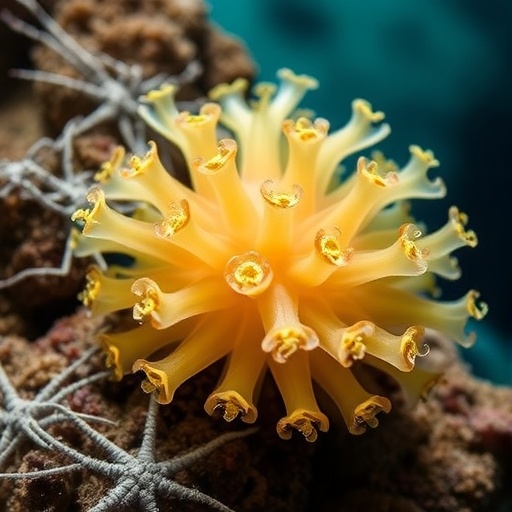In a groundbreaking study that explores the frontiers of microbiology, researchers have presented compelling evidence highlighting the potential of Ilimaquinone, a unique compound derived from marine sponges, as a natural antibacterial agent. This investigation targets the rising concern of antibiotic resistance among pathogenic bacteria, particularly in light of the urgent need for innovative solutions in antimicrobial therapy. Ilimaquinone’s multifaceted mechanisms of action, particularly its efficacy against biofilm formation and quorum sensing among bacteria, mark a significant leap in our understanding of how natural products can combat virulent strains.
Marine sponges have long been a source of bioactive molecules, showcasing a wealth of potential for pharmaceutical applications. Ilimaquinone, in particular, has been recognized for its structural uniqueness and the intricate biochemical pathways it affects. The present study zeroes in on its antibacterial properties that not only inhibit the growth of specific pathogens but also dismantle the hidden defenses those pathogens employ, such as biofilm formation. Biofilms can render bacteria resistant to conventional antibiotic treatments, making this an essential area of research.
.adsslot_DNsQSOVvxH{ width:728px !important; height:90px !important; }
@media (max-width:1199px) { .adsslot_DNsQSOVvxH{ width:468px !important; height:60px !important; } }
@media (max-width:767px) { .adsslot_DNsQSOVvxH{ width:320px !important; height:50px !important; } }
ADVERTISEMENT
Moreover, the researchers delved into the quorum sensing mechanisms, which bacteria utilize to coordinate their behavior in response to population density. These signaling pathways facilitate group behaviors that can enhance their virulence, making bacteria more formidable adversaries against the host’s immune responses. Ilimaquinone demonstrates an ability to inhibit this communication process, effectively “quieting” the bacteria and potentially leading to their eradication before a full-blown infection can manifest.
In light of such promising data, the implications for clinical applications of Ilimaquinone are profound. Existing antibiotics often fail due to resistance mechanisms acquired by bacteria, necessitating the search for alternative treatments. By targeting the fundamental processes that enable bacterial survival and virulence, Ilimaquinone embodies a paradigm shift towards more effective and sustainable avenues in medical treatment.
Additionally, the study emphasizes the ecological and evolutionary advantages of harnessing natural products like Ilimaquinone. The marine environment is one of the richest reservoirs of biodiversity, yet it is underexplored in many contexts. The identification and characterization of compounds derived from these ecosystems could provide a treasure trove of medicinal resources that can be innovatively applied to modern healthcare challenges. This research not only validates the potential of marine-derived molecules but also underscores the necessity for biodiversity preservation and the exploration of marine habitats for new drug discovery.
As researchers continue to unveil the mechanisms employed by Ilimaquinone, the potential for this compound manifests not just in its antibacterial activity, but also raises awareness regarding the importance of natural products in overcoming contemporary medical challenges. The technology enabled by understanding such mechanisms could lead to the synthesis of novel antibiotics informed by these natural blueprints.
The research team’s comprehensive approach, combining microbiological assays with advanced imaging techniques, showcases the power of interdisciplinary studies in deriving meaningful insights. By meticulously assessing the effects of Ilimaquinone at various concentrations, they illuminated the dose-dependent relationship between the compound and bacterial susceptibility. Such rigorous methodologies ensure the reliability of the results and offer a pathway for optimization in future clinical contexts.
Analyzing the broader implications, the findings advocate for therapeutic strategies that incorporate natural compounds in conjunction with existing medical practices. Combining Ilimaquinone with traditional antibiotics or integrating it into biocompatible delivery systems could pave the way for synergistic effects that enhance clinical outcomes. As we advance towards an era of personalized medicine, leveraging natural substances that align with our bodies’ biochemical pathways can yield highly effective treatment protocols.
Further research to explore the full pharmacological scope of Ilimaquinone is essential. Long-term studies assessing its effects in various biological systems would not only refine our understanding of its mechanisms but also provide a clearer picture of the compound’s potential in treating human diseases. Building on this foundational study, future explorations could investigate the possibility of utilizing Ilimaquinone in combination therapies designed to target specific pathogenic profiles or user-tailored treatment plans that consider individual microbiomes.
In conclusion, Ilimaquinone emerges as a significant contender in the ongoing battle against antibiotic-resistant bacterial strains. With its ability to inhibit biofilm formation and thwart quorum sensing, its application in clinical settings could significantly alter the course of treatment for chronic and recurrent bacterial infections. The ongoing exploration of marine-derived compounds like Ilimaquinone exemplifies the promising future of natural product research, heralding a new era in the quest for effective antimicrobial therapies.
This research serves as a vital reminder of the potential that lies within natural environments—waiting to be explored and understood. As we transition towards a more integrative approach in medicine, coupled with an appreciation of ecological complexity, we might just find the solutions to some of our most pressing health challenges in the depths of the ocean.
Subject of Research: Ilimaquinone as an antibacterial agent derived from marine sponges.
Article Title: Ilimaquinone as a novel marine sponge-derived antibacterial agent: mechanistic insights into its antibiofilm and quorum sensing inhibitory properties targeting bacterial virulence.
Article References:
Surti, M., Patel, M., Binsuwaidan, R. et al. Ilimaquinone as a novel marine sponge-derived antibacterial agent: mechanistic insights into its antibiofilm and quorum sensing inhibitory properties targeting bacterial virulence.
Int Microbiol (2025). https://doi.org/10.1007/s10123-025-00689-w
Image Credits: AI Generated
DOI: https://doi.org/10.1007/s10123-025-00689-w
Keywords: Marine sponge, Ilimaquinone, antibacterial agent, biofilm, quorum sensing, antibiotic resistance, natural products, microbiology, pharmacology, health challenges.
Tags: antibiotic resistance solutionsbacterial defense mechanisms dismantlingbiofilm formation inhibitionIlimaquinone antibacterial propertiesinnovative antibacterial agentsmarine sponges bioactive compoundsmicrobiology breakthroughsnatural antimicrobial therapypathogenic bacteria treatmentpharmaceutical applications of marine resourcesquorum sensing disruptionunique compounds from nature





